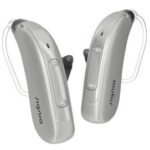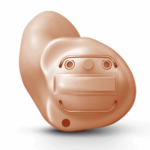Receiver-in-the-Canal Hearing Aids

Receiver-in-the-canal (RIC) hearing aids have a processor that sits behind the outer ear. However, the receiver is positioned in the ear canal and is connected to the processor by a thin wire.
The receiver is covered by a small rubber dome that helps the device fit comfortably in your ear canal. A custom dome can be made for this hearing aid upon your request. This type of hearing aid is appropriate if you have mild to severe hearing loss or struggle to hear certain pitches.
Almost all hearing aid manufacturers offer rechargeable RIC hearing aids, eliminating the need for replacement batteries.
In-the-Canal Hearing Aids

As the name implies, these devices fit completely in your ear canal. The mic and receiver are contained in a custom-made plastic shell that fits your ear shape. This style includes completely-in-the-canal (CIC) devices that fit deeper inside the ear canal and are almost invisible to the naked eye.
ITC hearing aids are best suited for moderate to severe hearing loss, while CIC devices treat mild to moderate hearing conditions. Their small size makes them ideal if you’re looking for a compact hearing device that won’t get tangled with mask straps or glasses.
The size of these hearing aids also reduces the likelihood of feedback while you’re talking on the phone. The hearing aid’s proximity to your ear reduces the effects of environmental noise, helping you focus on the sounds you want to hear.
In-the-Ear Hearing Aids

In-the-ear (ITE) devices fill the outer shell of your ear and house the mic, receiver and batteries in a single plastic case. These hearing aids are larger than ITC devices and can use directional mics to improve your hearing perception.
Like ITC models, ITE hearing aids are custom-fit to your ear. The larger size allows for more programming and volume control, and the bigger battery improves their longevity during daily use. They are available in full- or half-shell designs for various skin tones.
The design of this hearing aid style means you can customize the settings and adjust the functions to your specific needs. While these hearing aids are discreet, they’re still easy to handle if you have dexterity issues. ITE devices are suited for moderate to severe hearing loss.
Behind-the-Ear Hearing Aids

Behind-the-ear (BTE) hearing aids include a small plastic component that sits behind your ear. The hearing device’s microphone, receiver and batteries are housed in that compartment and connect to an earmold with a clear tube.
The earmolds situate the hearing aid’s snuggly into your ear canal to transmit audio. Earmolds and outer ear components are available in various colors, and certain brands can customize them to suit your ear shape. BTE hearing aids are intended for those with mild to profound hearing loss.
Thanks to the larger batteries, these devices can provide strong sound amplification for long periods. The mic and receiver location in your ear canal also reduces the amount of feedback and whistling and limits exposure to wax buildup. BTE hearing aids also come with Bluetooth connectivity.
Call 888-832-9966 or contact Audio Help Hearing Centers online to schedule your appointment and discuss types of hearing aids. If you have additional questions, check out the FAQs about our hearing aid devices.

